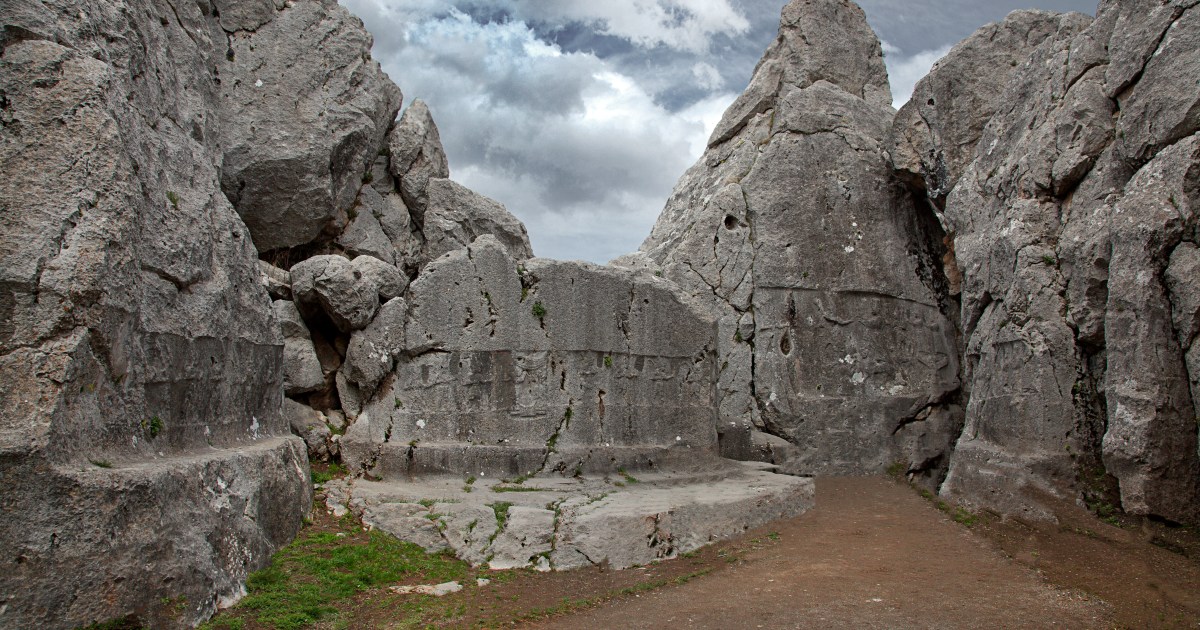The structure, which was built more than 3,000 years ago, may be an ancient calendar device that includes a map of the universe, according to a new interpretation that examines the implications of the ruins of "Yazilkaya", which was a sacred site for the Hittites in Chorum, near the Turkish capital, Ankara, and is characterized by its dramatic rocky outcrops. Impressive, antique rock carvings.
French archaeologist and historian Charles Texier found the Yazilkaya rock reserve in central Turkey, about 100 miles from Ankara, in 1834, but the inscriptions have remained mysterious and baffling to archaeologists, and it took nearly two centuries for experts to decipher what the marks mean.
And the Hittites civilization (1600-1178 BC) extended its control over Anatolia and northern Syria, and it was a match for its contemporary civilizations in Mesopotamia, Egypt and Persia.
In that period, with the end of the Late Bronze Age, it was divided into independent states in the Syrian lands, and some of them lasted for several centuries, until they were subject to the Assyrian Empire.
According to a new study - published in the "Sky scape Archeology" magazine - the elite of the Hittite society established the Yazilkaya site to embody their ideas about how the universe is organized, and the study indicates that the symbols carved in limestone rocks represent a giant calendar and time-measuring machine that is more than 3 years old. Thousands of years ago, and still working efficiently, "they used the open-air temple as an outdoor calendar and clock showing important astronomical dates with unmissable accuracy. The calendar itself works flawlessly even today," according to a team of Turkish, Swiss and American historians and astronomers.
A New Scientist report, written by Michael Marshall, says the site contains many images of rocky terrain, and the researchers behind the new interpretation argue that they have symbolic meanings related to the underworld, earth and sky, as well as nature's cycles such as the seasons.
“There are many connotations for deity names, arrangements, and groups,” says Eberhard Zanger, president of Luwian Studies, an international nonprofit.
"I'm not convinced by all the details, but I'm very interested in the whole thing," says Ian Rutherford, an academic who specializes in ancient history from Britain's University of Reading.
The shape of the current site of Yazilkaya dates back to about 1230 BC, and the Hittites - who have used the site for centuries - carved and modified natural rock outcrops to create two surfaceless spaces, decorated with rock-carved images of their deities.
It is not clear why the Hittites built Yazilkaya, or why they specifically used it, but several ideas have been proposed.
For example, one of the open spaces was used for New Year celebrations, while another was the mausoleum of a Hittite king.
In 2019, Zanger and his Swiss colleague Gauci Rita of the University of Basel in Switzerland suggested that some sculptures of deities might be a calendar capable of tracking solar years and lunar months.
Such a calendar was centuries ahead of its time, and that interpretation was welcomed by the scientific community.
Now, the duo and their colleagues have taken a new path;
Rather than focusing on the functions or potential uses of the inscriptions, scholars have considered what these carvings might mean to the Hittites.
"They had a certain picture of how creation took place," says Zanger. He adds that the Hittites imagined that the world began in a state of chaos, which became organized into 3 levels: "the underworld, then the earth we walk on, and then the sky."
In the same vein, Zanger says that the Hittites were projecting the polar stars, which never sink below the horizon, and he argues that a group of prominent deities at Yazilkaya represent the polar stars.
"There are images like this in ancient Egypt," he adds. The Hittites were influenced by many neighboring societies, including Egypt, but other sculptures may have connections to the earth and the underworld.
The second aspect of Hittite cosmology, Zanger says, is the "recurring renewal of life" (or the so-called eternal return).
For example, night follows day, dark moon turns into full moon, winter becomes summer and so on, and he argues that calendar-like sculptures reflect this cyclical view of nature and the universe.
According to academic and archaeologist Efrosini Potsikas of the University of Kent in Canterbury, UK;
The "idea is not so far fetched";
It was used by other cultures, from Mesopotamia near Anatolia to distant Central America.
Religious landmarks to connect terrestrial life to the wider universe.” This obviously makes sense, because that's exactly what religion does: it deals with cosmic interests, perceptions, and the place of human beings in the world.
The idea of "recurring or eternal repetition" was found in ancient Indian and Pharaonic philosophies, as well as dealt with by ancient Greek philosophers such as the Pythagoreans and Stoics, and it means that events are repeated over and over again in an endless time, and the idea has returned strongly in literary and cinematic works in the modern era.
However, Potsikas worries about that interpretation;
Many of the image research team's assumptions are not based on recital texts, which don't say much about astronomy.
Instead, scholars have used texts from Mesopotamian societies, which influenced the Hittites but were also different.
She says the evidence would be stronger if similar links between gods and astronomy could be found in other whereabouts.
The study concludes that there is much evidence of the impact of systematic astronomical observation and celestial knowledge on culture in Bronze Age societies in Egypt, Mesopotamia and Europe; The interest in celestial events also bears repercussions and influences that can be observed in recital manuscripts, architecture and the arts.

